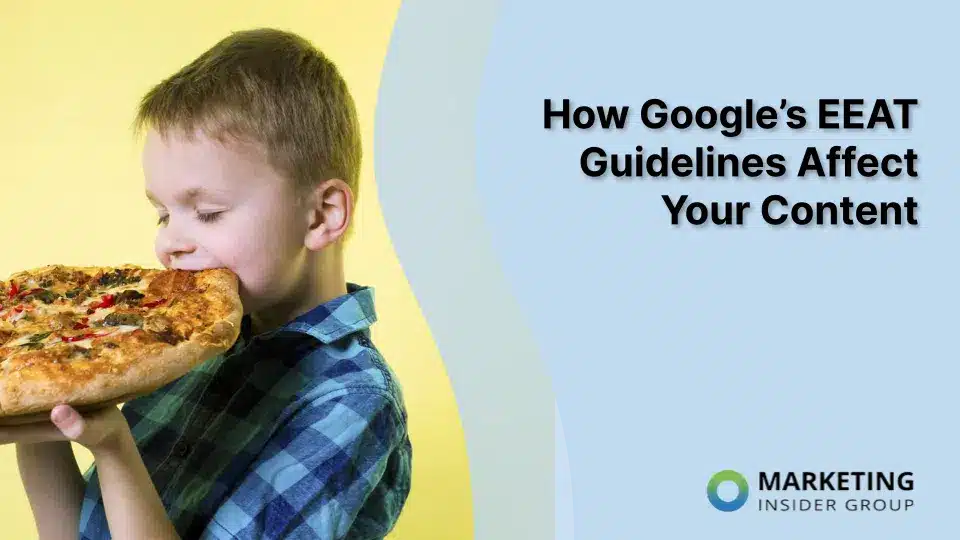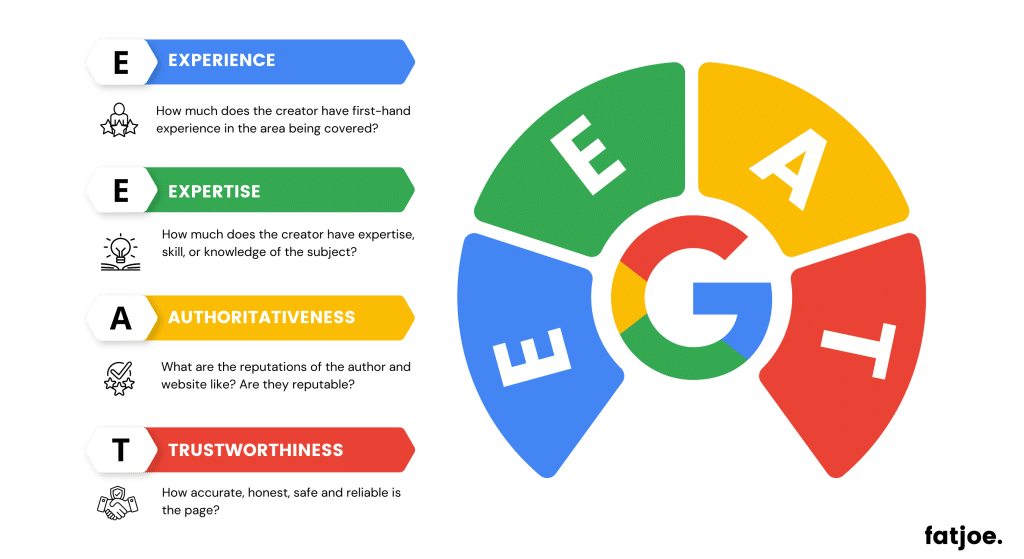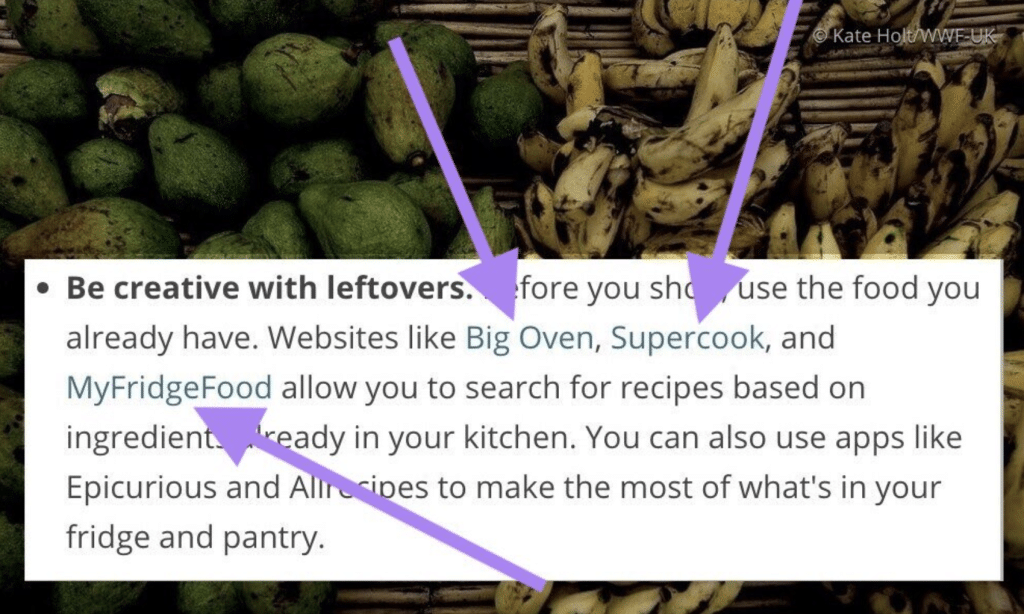
How Google’s EEAT Guidelines Affect Your Content
Back in 2014, Google introduced something called “EAT” in their guidelines. It’s become a big deal for anyone who wants their content to perform well on Google SERPs. In 2018, it became even more important after Google’s Medic update. More recently, they added another “E” to the equation, leaving us with today’s Google EEAT.
Long story short: If you want your website to show up at the top of Google search results, you need to understand and abide by Google’s guidelines. In this post, we’re covering Google EEAT, how it affects your content, and how you can make sure your content abides by this framework. In turn, you’ll see higher rankings, better engagement, and more traffic.
Quick Takeaways
- Google EEAT evaluates content quality using Expertise, Experience, Authoritativeness, and Trustworthiness criteria.
- EEAT, while not a direct “algorithmic factor,” has a major influence on how Google’s raters assess content quality.
- Google prioritizes content quality, source credibility, website security, user engagement, and brand thought leadership.
- To rank higher, creators should focus on content quality, storytelling, credible sources, backlinks, credibility signals, customer reviews, and industry thought leadership.
What is Google EEAT?
Google EEAT stands for Experience, Expertise, Authoritativeness, and Trustworthiness. It’s a framework used by Google to evaluate the quality of content on web pages, especially in the context of its search quality evaluator guidelines.

Image Source: Fat Joe
Here’s a more detailed breakdown of each component:
- (E)xperience. It’s not just about what you know, but also how you apply it. Experience speaks to the practical application of knowledge. It’s the difference between reading about a software update and actually implementing it in real-world scenarios.
- (E)xpertise. This refers to the depth of knowledge or skill in a particular area. For example, if you’re a software company, Google wants to see that your content is written by experts in the software industry.
- (A)uthoritativeness. This is about recognition. Are other reputable sites in your industry referencing your content? Do they see you as a thought leader? It’s one thing to claim expertise, but being recognized by peers amplifies your credibility.
- (T)rustworthiness. Nowadays, trust is more important than ever. Google wants to make sure that sites with high rankings are reliable and safe for users. This means not only providing accurate information, but also providing a secure browsing experience.
Google’s emphasis on EEAT is part of its ongoing effort to help users find high quality, relevant, and trustworthy content in their search results.
What Google EEAT Means For Your Content
While EEAT isn’t a direct “algorithmic factor,” it plays a significant role in how Google’s human search quality raters evaluate and understand the quality of content on web pages. These evaluations help Google refine its algorithms to prioritize high quality content in search results.
This means that Google EEAT plays a major role in whether or not your content reaches its audience. If you want your content to perform in SERPs, here’s what you need to know:
- Quality over quantity. Gone are the days when churning out content in bulk guaranteed visibility. With EEAT, Google emphasizes content usefulness over length. If you’re sharing expertise in a particular area, make sure it’s thorough, accurate, and valuable to your audience.
- Credibility matters. Google wants to serve content from sources that are authoritative and trustworthy. This means your content should not only be well-researched, but also recognized and cited by others in your industry.
- Engagement as a metric. If users find your content valuable, they’ll engage with it through longer read times, shares, or comments. Google sees this engagement as a sign of your content’s quality and relevance, further boosting your SEO.
- Building relationships. EEAT is about establishing your brand as a thought leader. By consistently producing content that showcases your expertise and earns trust, you’re not just improving your SEO, but also building lasting relationships with your audience.
- Safety first. Trustworthiness goes beyond just the accuracy of your content. Google also evaluates the security of your website. Making sure your site is secure, especially if you handle customer data, can positively impact your SEO.

Image Source: Semrush
Google’s algorithms are complex and take many factors into account when determining search rankings. The EEAT principles provide a guideline for content creators to understand what Google views as high quality content.
By aligning your content with EEAT principles, you can not only boost visibility and ranking in search results, but also keep your highly-ranked content at the top of SERPs.
Boosting Your Content’s EEAT
Almost 68% of all clicks on SERPs go to the first five results on page one. So, how do you get your content to rank in one of those top five spots?
Follow the Google EEAT framework. By focusing on these principles, you’re not just optimizing for search engines, but rather creating content that resonates and leaves a lasting impact.
Here’s a closer look at what you can do to boost your content’s EEAT:
1. Create High Quality Content
The foundation of any reputable online platform is its content, so every piece you produce should be of the highest quality.
The most successful content is based on original research, has a variety of titles and subheadings, is updated every 6-12 months, and provides a valuable reader experience.
Focus on providing accurate, in-depth, and original information. By consistently sharing valuable content, you not only cater to your readers, but also position your platform favorably in the eyes of search engines like Google. Always prioritize the needs and interests of your audience.
Here’s a short video with more tips on creating high quality content:
Video Source: In Front Marketing
2. Leverage Storytelling
The art of storytelling has the power to transform even the most complex information into an engaging narrative. By incorporating stories into your content, you can make your message more relatable and memorable. It’s not just about laying out the facts, but rather connecting with your audience on a deeper level.
3. Cite Sources
To enhance the credibility of your content, always cite your sources–and use credible ones. Content with cited data is higher performing, with 5% of high-performing articles having data studies, compared to 2% of low-performing articles.
When you make a claim or reference a study, provide a link or mention the source. This will not only reinforce the authenticity of your content, but also demonstrates to your readers that you value accuracy and thorough research, leading to enhanced trust.
4. Build Backlinks
When they’re from reputable websites, backlinks are like endorsements for your content. They signal to search engines that your platform is a valuable, reliable resource.

Image Source: Semrush
To earn quality backlinks, think about using strategies like:
- Guest posting
- Collaborations
- Outreach
It’s also important to include visuals in your content, like images, videos and infographics. A recent study shows that articles with 7 or more images get 555% more backlinks and 259% more page views than those without images.
5. Include Credibility Signals
It’s key to provide tangible evidence of your expertise and credibility. Post any relevant certifications, memberships, or awards on your platform. If you’ve been recognized or featured in well-known publications, make sure to highlight that. These kinds of signals will reassure both your readers and search engines about your authority.
6. Encourage Customer Reviews/Testimonials
Feedback from happy customers can really boost your platform’s reputation. Encourage your clients to share their experiences and testimonials. These will help build trust among potential customers and highlight your commitment to quality and customer satisfaction.

7. Be a Thought Leader
To really stand out, you need to be able to anticipate and influence trends in your industry. By sharing your own unique insights, forecasting industry changes, and voicing your (educated) opinions, you can establish yourself as a thought leader. This not only enhances your EEAT, but also positions you as a go-to authority in your field.
Create High Quality Content Today with MIG
The Google EEAT framework focuses on the importance of quality, credibility, and trustworthiness. As content creators, it’s our job to make sure our content not only meets, but exceeds these standards. By embracing Google EEAT principles, we can create content that both ranks well and genuinely serves and resonates with our audience.
Are you ready to create high quality content consistently? Check out our SEO Blog Writing Service or schedule a quick consultation to learn more about how Marketing Insider Group can help you earn more traffic and leads for your business.






